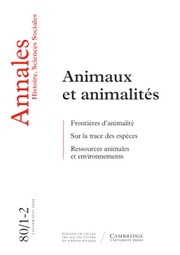Article contents
Aspects du système de parenté inca
Published online by Cambridge University Press: 25 May 2018
Extract
Pour la période qui va de la fin du XVIe siècle au début du XVIIe, les matériaux susceptibles d'éclairer la signification des termes de parenté inca figurent dans les sources suivantes : l'Arte et le Vocabulario, de Domingo de Santo Tomas, imprimés tous deux à Valladolid, en 1560 ; l’Arte de la lengua general, ouvrage anonyme (attribué à Juan Martínez Oramechea), imprimé pour la première fois en 1586 à Séville où il fut réimprimé en 1603, puis à Lima, en 1604 et 1614 ; l’Arte et le Vocabulario de Diego González Holguín, imprimés à Lima en 1607 et 1608 respectivement ; l'Arte de Diego Torres Rubio, imprimé à Lima en 1619 ; et le Ritual formulario de Juan Pérez Bocanegra, imprimé à Lima en 1631. On est surpris de la somme considérable de matériaux que fournissent ces sources ; et si l'ambiguïté demeure en ce qui concerne les traductions d'un certain nombre de termes particuliers, quantité d'autres en sont remarquablement exempts, grâce aux spécifications descriptives qui font suite aux traductions initiales.
Summary
Through the analysis of the Inca kinship terminology found in various historical sources, the author attempts to construct a theory of the System which accommodates all the data, whatever their apparent contradictions or inconsistencies might be. It is a bifurcated merging system displaying an obvious Omaha character (through extension of some of the kinship terms: MB = MBs), with some evidence, as well of asymetrical matrilateral cross-cousin marriage (MB, MBs = WF, WB, BWB, sWF, sWFF, ssWF). However, some of the terminology is clearly Crow in character, and this fact suggests the existence of the quite contrary Crow-type principle of reckoning as opposed to the Omaha-type principle (matrilineal us patrilineal).
The author's hypothesis is that the two principles might be employed simultaneously in one and the same System, but in totally separate domains, in accordance with a principle of parallel descent, in the agnatic line for men and in the uterine line for women. Indeed, some terminological data (e.g. a man uses the term ususi, daughter, for his dddd) constrain the author to posit three-generation cycles, which result from matrilateral cross-cousin marriage among just three unilineal descent groups (minimum number for the maintenance of asymmetry). The combinations among these various terminological features of the Inca kinship system imply that any matrilateral cross-cousin marriage is also a patrilateral one; in other words, the MBd is at the same time the FFSdd, in conformity with the paralell descent principle. These conclusions are supported, at least with regard to parallel descent, by specific evidence concerning the transmission of names in historical times. The author also puts forward the hypothesis (which, however, is impossible to verify given the data available) that the Quechua of Cuzco during the Inca period did in fact conceive the matrilateral cross-cousin marriage as a marriage between a man and his F2Sd2
- Type
- Systèmes de Classification
- Information
- Copyright
- Copyright © Les Éditions de l’EHESS 1978
References
Notes
1. Pour des études plus détaillées sur les systèmes de parenté andins actuels (et d'autres interprétations) voir le recueil publié récemment par R. Bolton et E. Mayer, Andean Systems of kinship and marriage, American anthropological association, 1977.
1. Ce travail a été lu au Congrès des Américanistes à Barcelone (1964) ; repris ultérieurement lors des conférences en l'honneur de L. H. Morgan (Univ. de Rochester. 1970). L'auteur propose de reprendre le sujet dans une oeuvre en préparation, Historical studies in the language of kinship.
2. Cf. Scheffler et Lounsbury, 1971.
3. Scheffler et Lounsbury, 1971. pp. 186-188.
4. M. Fortes, 1950.
5. Perez Bocanegra, 1631.
6. Zuidema, 1964.
7. Scheffier et Lounsbury, 1971, p. 85.
8. Tello, 1922.
- 2
- Cited by


